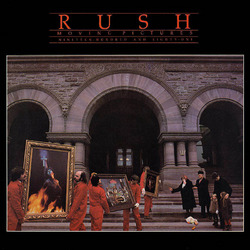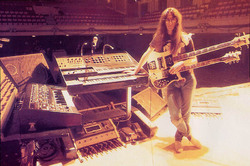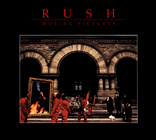Rush: Moving Pictures Blu-ray Movie
HomeRush: Moving Pictures Blu-ray Movie 
Blu-ray Audio / Blu-ray + CDMercury | 1981 | 40 min | Not rated | Apr 05, 2011
Movie rating
6.8 | / 10 |
Blu-ray rating
| Users | 3.5 | |
| Reviewer | 4.5 | |
| Overall | 3.7 |
Overview
Rush: Moving Pictures (1981)
Starring: Geddy Lee, Neil Peart, Alex Lifeson| Music | 100% |
Specifications
Video
Video codec: MPEG-4 AVC
Video resolution: 1080i
Aspect ratio: 1.33:1
Original aspect ratio: 1.33:1
Audio
English: LPCM 2.0 (96kHz, 24-bit)
English: LPCM 5.1 (96kHz, 24-bit)
English: DTS-HD Master Audio 5.1 (96kHz, 24-bit)
Subtitles
None
Discs
25GB Blu-ray Disc
Two-disc set (1 BD, 1 CD)
Playback
Region free
Review
Rating summary
| Movie | 4.5 | |
| Video | 2.0 | |
| Audio | 5.0 | |
| Extras | 3.5 | |
| Overall | 4.5 |
Rush: Moving Pictures Blu-ray Movie Review
Say 'Yes' to Rush on Blu-ray.
Reviewed by Jeffrey Kauffman April 28, 20111981 was a very interesting transitional year in the music industry. The era of the long playing vinyl album was already seeing its epitaph written on the virtual wall, though compact discs were still a couple of years off, at least from a mass market consumer standpoint. Music itself was changing, too, with the once ubiquitous punk rock genre fading into the background. The early 1980s were the era of “hair bands” and big arena rock, but 1981 started on a somber note as the music world was still reeling from the December 1980 assassination of John Lennon. A number of huge albums appeared that year, shaking off the doldrums from this horrible event, and a number of major bands also decided to call it quits that year as well. Though they later regrouped (repeatedly), Yes announced their dissolution in April of 1981. Probably completely unrelated, though kind of interesting from a hindsight perspective, was the arrival of what is arguably Rush’s most “Yes”-like album, Moving Pictures, in February of 1981. Though Rush has had an enormous impact in rock, managing to chalk up an astounding number of platinum albums which make the group (as incredible as it may seem) third in the amount of consecutive Gold or Platinum studio rock albums (behind The Beatles and The Rolling Stones), the band has never really seemed to get their due from the public at large. Part of this might be attributable to the patently bizarre vocal stylings of Geddy Lee, who has been dismissed as a sort of “Jon Anderson-lite” figure, albeit one more prone to a declamatory vocal style than Anderson’s more plangent approach. It may simply also be due to the fact that in Rush’s heyday, virtuoso progressive rock bands were a dime a dozen, and this Canadian trio, for all their chart and touring successes, somehow got lost in the shuffle. The good news is that with this stellar re-release of what became Rush’s most impressive American success, listeners get a chance to reevaluate what had made Rush one of Canada’s crowning achievements in rock, and what continues to make the band a compelling presence now some 30 years (wow!) after Moving Pictures’ initial release.

Moving Pictures has attained an iconic status in the history of 80s rock and remains what is arguably Rush’s most defining achievement, at least in terms of its prog-rock proclivities. The album is full of brilliant flourishes and maintains a nice balance between proto-classical showiness and hard rock riff driven sensibilities. While perhaps not as hyperbolic as some of Yes’ florid albums, Moving Pictures segues as effortlessly between idioms as any of Yes’ albums, and Moving Pictures also stands as one of Rush’s last explorations in extended song forms (“The Camera Eye” runs just one second shy of eleven minutes). But the album is a brilliantly diverse assortment of both songs and instrumentals, and it includes several of Rush’s best known anthems, including “Tom Sawyer,” “Limelight” and “Red Barchetta.”
Geddy Lee’s voice is one of those incredible instruments that simply needs to be experienced to be believed, and his supersonic tenor is in full flower on this album. Though his early work was often compared to Robert Plant, it’s just as redolent of Yes’ Jon Anderson on this album, though Lee is prone to squeals and shouts as he marauds his way through Neil Peart’s lyrics (Pye Dubois co-wrote the lyric for “Tom Sawyer”). Soaring over dense clouds of synth washes and the pounding bass of Lee himself as well as the incredibly forceful drums of Peart, Lee’s voice is magical and at times a little frightening in a sort of bizarre way. Is it possible any normal human is able to sing this high? Lee’s amazing tenor is one of the most distinctive sounds in modern rock, and Moving Pictures probably is one of his finest hours as a vocalist.
The band is in incredibly fine form throughout this outing and perhaps proves its formidable chops as much if not more in the instrumental offerings than as accompanists for the vocal tunes. The Grammy nominated “YYZ” is a sterling example of just how smart these players are. The title of this song refers to the airport code for Toronto’s Pearson International Airport, and that “stuttering” riff which starts the tune off in such a memorable manner is actually Morse Code for the title. But over and over Rush proves what masters they are of modern rock “orchestration,” subtly blending guitars and synthesizers in wonderfully varied ways to create an amazing assortment of sonic colors and moods.
One of Rush’s signal achievements in Moving Pictures is the band’s confident entry into confessional singer-songwriter territory without becoming maudlin or self-absorbed. Tunes like “Red Barchetta” and “Limelight” offer a peek inside Peart’s state of mind at this moment in the band’s incipient superstardom, and there’s a certain nostalgic melancholy that wafts through several of the songs. But alongside these more introspective moments are balls-out hard driving rock extravaganzas that prove Rush can head-bang with the best of them. In fact probably the greatest achievement of Moving Pictures is just how diverse the album as a whole really is.
Moving Pictures has been a mainstay of rock radio virtually since the moment it was released, and it’s invigorating to realize that the album has lost none of its punch or even its relevance some 30 years after its release. Having a classic rock album like this debut on Blu-ray will be a treat for longtime fans, but a top selling release like this may be just the shot in the arm that the fledgling Blu-ray audio format needs to really become a consumer favorite. The complete contents of the original album are included on this Blu-ray:
- Tom Sawyer
- Red Barchetta
- YYZ
- Limelight
- The Camera Eye
- Witch Hunt
- Vital Signs
Rush: Moving Pictures Blu-ray Movie, Video Quality 

Though this is ostensibly an audio Blu-ray, there are around 13 minutes of bonus video also included on this Blu-ray (see the Supplements section below for full details on the actual content). Though delivered here via an AVC codec in 1080i and 1.33:1, this is pretty shabby looking video from the dawn of the home video age. This appears to have been shot with what was then probably a high-tech handheld home video camera, and the results are not very impressive. Incredibly soft and devoid of much color, visually this isn't much to look at, but as an historical record of the sessions that produced Moving Pictures, it's invaluable. "Vital Signs" is offered with a bunch of posterizing effects that actually make it seem like better quality than it probably is.
Rush: Moving Pictures Blu-ray Movie, Audio Quality 

Wow. What more can one say about the quality of at least two of the three lossless tracks offered on this incredible (mostly) audio Blu-ray? Oddly, and for one of the very few times I've experienced this in my reviewing careers, the lossless LPCM 2.0 stereo fold down (24-bit/96kHz) sounds surprisingly pallid when stacked up against the two lossless 5.1 tracks. The low end is especially weak on this 2.0 mix, so if you have the ability to experience the surround mixes, by all means, do so. Two brilliant 5.1 options are offered, an LPCM 5.1 and a DTS-HD Master Audio 5.1, and I personally would be hard pressed to find much if any difference between them. Both are presented with 24-bit/96kHz resolution, and the results are, to put it simply, astounding. The clarity and nuance that is now available to listeners of Moving Pictures presents whole new worlds of sonic activity. Multilayer synths which were before just kind of part of a muddled mass now ring out with singular clarity. Some of the sound effects utilized on a couple of the tunes are much more evident than they've ever been before. The utilization of the surround channels is brilliantly handled, and longtime fans of this album are in for some revelatory listening, as suddenly they'll find themselves centrally placed in an incredibly active soundfield. Fidelity is brilliant, with unbelievably facile dynamic range. As the boys of Rush tell us on one of the text entries on this Blu-ray, the increased resolution of Blu-ray audio means that this was actually mixed lower than traditional CDs or SACDs, so they recommend turning up the volume. I second that recommendation.
Rush: Moving Pictures Blu-ray Movie, Special Features and Extras 

Rush and Mercury have really stepped up to the plate in terms of understanding exactly what Blu-ray as a medium can offer. Not only are we given reference quality audio, there are a number of nice supplements and options on the Blu-ray:
- Music Videos (1080i; 13:32). As mentioned above, a fairly brief video extra is offered on the Blu-ray, namely three music videos for "Tom Sawyer," "Limelight" and "Vital Signs". The video quality leaves a lot to be desired, but it's fun to see actual session footage (or at the least, convincing recreations).
- Photo Gallery
- Lyrics. Though it may not be intuitively obvious from the main menu, navigate over to the right side of the screen. If you click "Lyrics" you will get karaoke-esque screens of the individual tunes' lyrics as they play, interspersed (perhaps a bit funnily) with a glyph of a note when there's just music (I guess just in case you were confused).
- CD included
Rush: Moving Pictures Blu-ray Movie, Overall Score and Recommendation 

Rush may be thought of as a sort of prog-rock also-ran, as wrongheaded as that opinion may be, but with this incredible new Blu-ray audio release of the band's biggest stateside seller, Moving Pictures, the proof is in the audio pudding. Filled with an astounding variety of styles and expert playing, this is fantastic music that sounds absolutely stellar in its high definition debut. Whole new layers of complexity are unveiled in this sparkling presentation, and Mercury has really upped the ante for future catalog releases on Blu-ray by providing a handsome package that includes some very smart supplements. Highly recommended.
Other editions
Rush: Moving Pictures: Other Editions
Similar titles
Similar titles you might also like

Rush: R30
2005

Rush: Snakes and Arrows Live
2008

Rush: Time Machine, Live in Cleveland
2011

Rush: 2112
Deluxe Edition | Blu-ray Audio
1976

Rush: 2112 and Moving Pictures
Classic Albums
2010

Rush: Beyond the Lighted Stage
2010

Porcupine Tree: Anesthetize
2010

Rush: Clockwork Angels Tour
2013

The Raven That Refused to Sing
Steven Wilson
2012

Get All You Deserve
Steven Wilson
2012

Rush: R40 Live
2015

Jeff Beck: Performing This Week... Live at Ronnie Scott's
2007

Heaven & Hell: Radio City Music Hall Live!
2007

Dream Theater: Live At Budokan
2004

Iron Maiden: Flight 666
2008

The Big 4: Metallica, Slayer, Megadeth, Anthrax - Live From Sofia, Bulgaria
2010

Dream Theater: Live at Luna Park
2012

Iron Maiden: En Vivo!
2012

Led Zeppelin: Celebration Day
2012

The Who at Kilburn: 1977
1977

